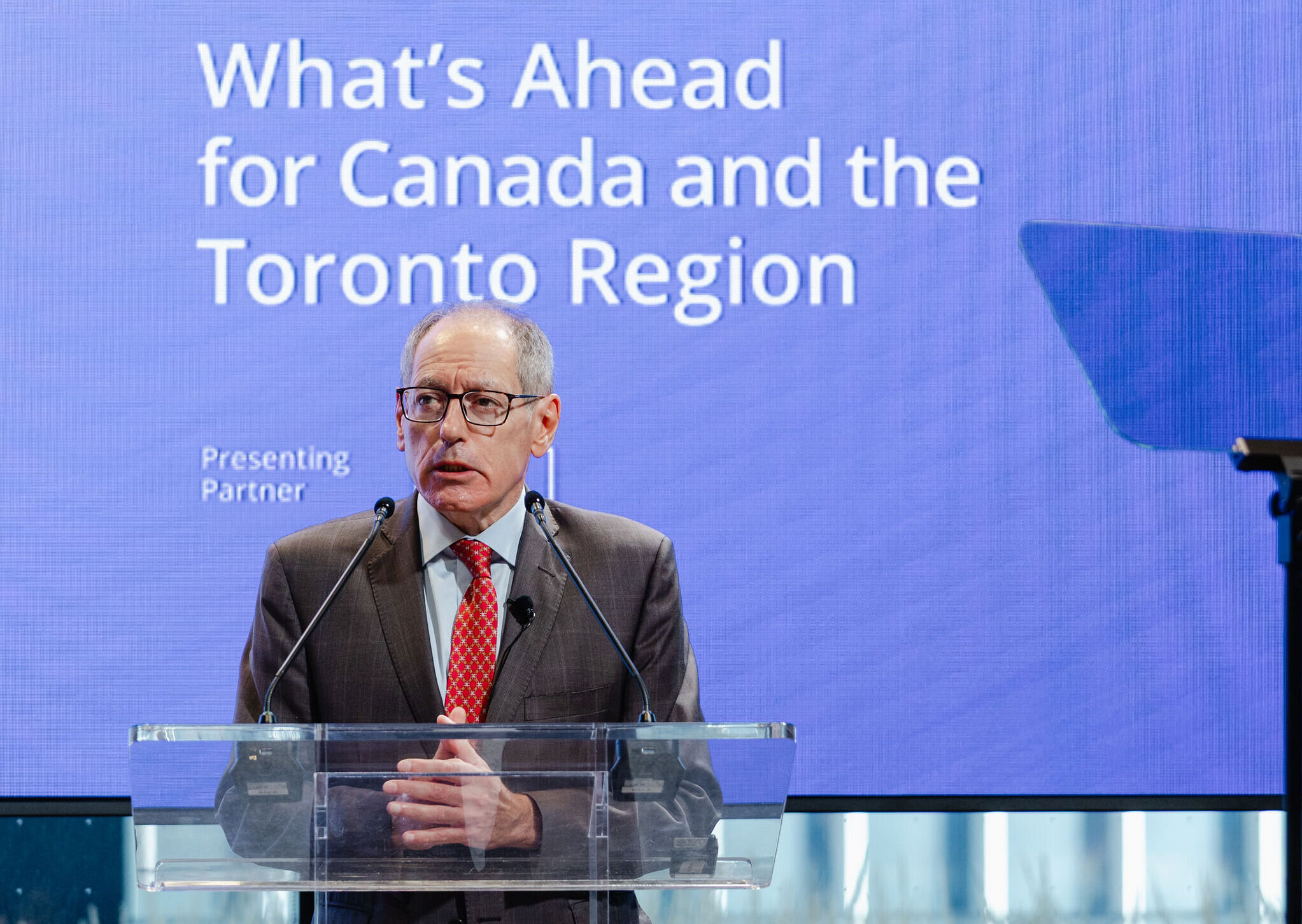Every economy tells a story of choices made and time lost. For Canada and the Toronto Region, those choices are catching up.
At our recent event, RBC Capital Markets Senior Economist Claire Fan delivered a data-driven and sobering update on where Canada stands. Fan described a country that has grown but not advanced: GDP lifted by population gains while productivity and investment lag. CUSMA still shields most cross-border trade, yet widening U.S. protectionism, especially national security–based Section 232 tariffs on steel, aluminum, lumber, and heavy trucks, is testing that protection and exposing the limits of Canada’s growth model.
Ross Prusakowski, Deputy Chief Economist and Director of Country & Sector Intelligence at Export Development Canada, traced where that strain is hitting first: manufacturing jobs lost, exports redirected, and resilience holding for now but under pressure. Where Fan saw the early signs of slowdown, Prusakowski warned that a mild recession may already be forming in Ontario’s most trade-exposed sectors.
It was a point echoed by our President and CEO, Giles Gherson, who framed the challenge not as a passing shock, but as a reckoning: “We’re not just managing through tariffs, we’re living with the costs of twenty years of underinvestment in productivity. Tariffs are the spark, but the fire was already burning.”
Canada’s growth is widening the gap between size and strength
Claire Fan showed that while Canada’s economy has expanded, it has not become more productive. Real per-capita GDP has fallen through consecutive quarters, revealing an economy “growing in size, not in strength.” Fan linked that weakness to years of under-investment and slower capital formation, warning that without renewed business investment, “the speed limit” on growth will stay low.
CUSMA remains the backstop, but its coverage is shrinking
Fan outlined how roughly 90 percent of Canadian exports still cross the border duty-free under CUSMA, but the remaining 10 percent — especially steel, aluminum, lumber and heavy trucks — are being hit by new Section 232 tariffs. Those measures, she said, are “pushing more and more products outside the umbrella that’s been protecting us.”
Ontario’s manufacturing base is taking the hit
Employment losses and output declines are concentrated in trade-exposed industries. Fan’s data showed double-digit unemployment in Windsor and declines across manufacturing and warehousing. As Prusakowski added, “That’s where the slowdown is real, the tariff shock is landing first and hardest in Ontario.”
Regional divergence is already here
Western provinces are benefitting from energy exports, while Ontario and Quebec absorb the brunt of tariff-driven slowdowns. Prusakowski cautioned that Canada could see “a recession in parts of the country even if the national picture stays just above zero.”
Capital exists, opportunity doesn’t
Both speakers agreed Canada doesn’t face a capital shortage, but an opportunity shortage. “The money is here,” Fan said. “What we lack is the ability to move it quickly.” Prusakowski noted that project delays and regulatory layers are “slowing investment exactly when we need it to accelerate.”
90%
Share of Canadian exports to the U.S. that still enter duty-free under CUSMA.
10%
Portion of the exports now exposed to Section 232 Tariffs on steel, aluminum, lumber, and heavy trucks — up sharply since spring 2025.
8.5%
Toronto's unemployment rate — among the highest of any major Canadian city.
13 -14 %
Increase in Canadian exports to non-U.S. markets so far this year; U.S. exports down 3 percent over the same period.

“The economy looked like it was growing through 2022 and 2023, but on a per-capita basis it’s actually been falling for quite a bit… When you add more people, the economy gets bigger, but that doesn’t mean it’s growing naturally. Our growth has come from adding people, not productivity. That’s the bigger story.”
— Claire Fan, Senior Economist, RBC Capital Markets
“Our latest forecast has a mild recession already built in. We had a negative quarter in the second quarter, and Q3, even with early data, isn’t looking amazing. There was a significant pull-forward in U.S. demand in the first half of the year, it allowed them to re-examine their trade relationships, and we think that’s going to carry on to the second half of this year and that’s going to hit Canada. Once you consider things like energy, the pie is not the same size, we’re quite concerned in terms of the impacts of tariffs going forward.”
— Ross Prusakowski, Deputy Chief Economist, Export Development Canada

“What we’re hearing day after day are stories of manufacturers in Ontario buying businesses in the U.S. or expanding there just to survive. The investment outflow that’s been draining our capacity for a decade is now accelerating. The 10 per cent of our trade under tariffs may sound small, but that’s where the damage is deepest, and that’s where the future of our economy sits.”
— Giles Gherson, President & CEO, Toronto Region Board of Trade
Thank you to our event partners for helping to make this event a success.